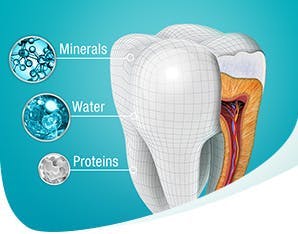How to Help Prevent Cavities in Children
Cavities are all too common in children, with cases occurring in an estimated 40% of children ages 2 to 19 years old.1
As a parent or caregiver, you are in the position to help prevent your child from getting cavities. By taking a proactive role in teaching your child good oral hygiene and encouraging a cavity-conscious diet, you’re helping yourself and your loved ones by investing in a (hopefully) cavity-free future and fewer dental visits.1
What Causes Cavities in Children?
It’s no secret to most that sugar and poor oral hygiene are often the culprits behind cavities.1 But why?
The Link Between Sugar & Cavities
Acid-producing bacteria in the mouth love sugar.1 When exposed to sugar, these bacteria undergo a fermentation process and produce acid as a byproduct and lower the pH in the mouth which makes the mouth biome acidic.1 The low pH caused by the acid can then result in demineralization--the weakening of enamel, which greatly increases the risk of cavities developing.1
How do we get rid of this plaque bacteria? By brushing with a fluoride toothpaste and flossing daily, as well as making regular visits to your dentist.1,3 These are all the important components of good oral hygiene. Teach your kids proper oral hygiene like brushing twice daily and flossing at least once per day to prevent developing cavities.1,3
Social Determinants of Health Can Impact Oral Hygiene
Sometimes, it's not as simple as poor oral hygiene and eating too much sugar. Social determinants of health (SDH) are the non-medical factors that influence health outcomes, and include conditions such as how people are born, grow, work, live and age.4 These conditions also include a wider set of economic policies and systems that can have an important influence on oral health equity.4 Some social determinants of health that can influence health equity in positive and negative ways include:4
- Income and social protection
- Education
- Unemployment and job insecurity
- Working life conditions
- Food insecurity
- Housing, basic amenities and the environment
- Early childhood development
- Social inclusion and non-discrimination
- Conflicts
- Access to health services
Good oral hygiene is ultimately what helps prevents cavities, and if there are barriers to maintaining it, avoiding cavities may be easier said than done.1
Tips for Preventing Cavities in Children
In addition to limiting sugar, there are several actions and habits that you can develop to keep your kids from getting cavities.
Limit Sugary Foods
If your child is constantly asking for a sweet treat, it can be tempting to cave in and let them. While it’s okay to let them have their treat here and there, it’s best to limit them between meals.1 Limit fruit juices, candy, soft drinks, sticky foods, chips and opt for healthier (and tasty) snacks for your kids like unsweetened yogurt, peanut butter and cheese.1
Avoid Sugary Foods Before Sleep
Of course, try to have your kids limit sugary foods in general, but most importantly, before sleep. When your child eats sugar before sleeping, the bacteria that turn sugar into acids sit in the mouth throughout the night, thus increasing the risk of cavities.1
If your younger child is still drinking from a bottle or sippy cup and what they are drinking isn’t water, your child is at a greater risk of developing cavities since they’re continuously exposing their teeth to sugar acids.1 Add water to a sippy cup or bottle before bed, not milk or sugary drinks.
Have Them Drink Fluoridated Tap Water
Fluoride helps prevent cavities.1 That’s why fluoride is often present in tap water to ensure that cavities don’t become widespread through communities.1 Have your child drink tap water between meals to rinse away sugar acids and help protect teeth.1 By comparison, bottled water does not contain an adequate amount of fluoride.1
Dental Sealants
Dental sealants are an effective way to prevent cavities in children and adolescents.2 Dental sealants are thin coatings that are placed on the top (biting surface) of the back teeth (your kid's molars).2 It’s been observed in school-age children ages 6 through 11 that those without dental sealants had three times as many cavities in the first molars compared to kids with sealants.2
Teach Them Good Oral Hygiene from a Young Age
It’s a best practice to start your children on the right path to good oral hygiene by nurturing those habits from a young age. Have your child brush at least twice a day with a fluoride toothpaste and floss at least once a day.3
To keep your baby’s mouth clean, use a soft cloth to wipe their gums.5 Once their first teeth start coming in, begin brushing them with a soft, child-sized toothbrush and use a rice-sized amount of fluoride toothpaste.5 This will help minimize the amount of toothpaste that your child swallows.5 Once your child gets better at spitting (around age 3), you can use a pea-sized amount of toothpaste.5 Make sure your child spits after brushing.5 Help your child brush their teeth until age five or six.5 You can use stickers as prizes to help motivate your child to brush their teeth.5 If you have access, take your child to the dentist every 6 months.
Teaching good habits earlier can help your child to develop positive oral hygiene habits, the more likely they will enjoy a healthier smile in the future. What’s more, leading by example will help you develop these habits too. Keep up with a good routine, and all should stick eventually.
Source Citations:
i. Maintaining and Improving the Oral Health of Young Children. American Academy of Pediatrics. https://publications.aap.org/pediatrics/article/151/1/e2022060417/190307/Maintaining-and-Improving-the-Oral-Health-of-Young?autologincheck=redirected. Accessed 05/29/2024.
ii. Fast Facts: Dental Sealants. CDC – Oral Health. https://www.cdc.gov/oral-health/data-research/facts-stats/fast-facts-dental-sealants.html?CDC_AAref_Val=https://www.cdc.gov/oralhealth/fast-facts/dental-sealants/index.html. Accessed 05/29/2024.
iii. A Child’s First Dental Visit Fact Sheet. Stanford Medicine Children’s Health. https://www.stanfordchildrens.org/en/topic/default?id=a-childs-first-dental-visit-fact-sheet-1-1509. Accessed 05/29/2024.
iv. Social determinants of health. World Health Organization. https://www.who.int/health-topics/social-determinants-of-health/. Accessed 8/12/2024.
v. A Mom’s Guide to Fluoride. https://www.mouthhealthy.org/life-stages/babies-and-kids/moms-guide-to-fluoride. Accessed 8/20/2024.



